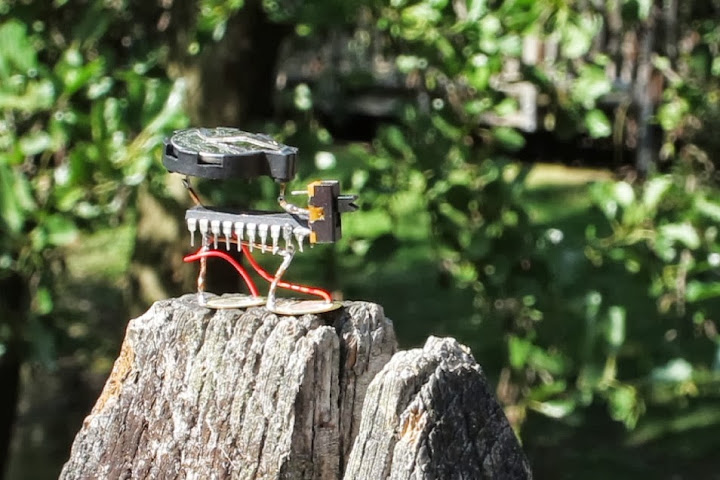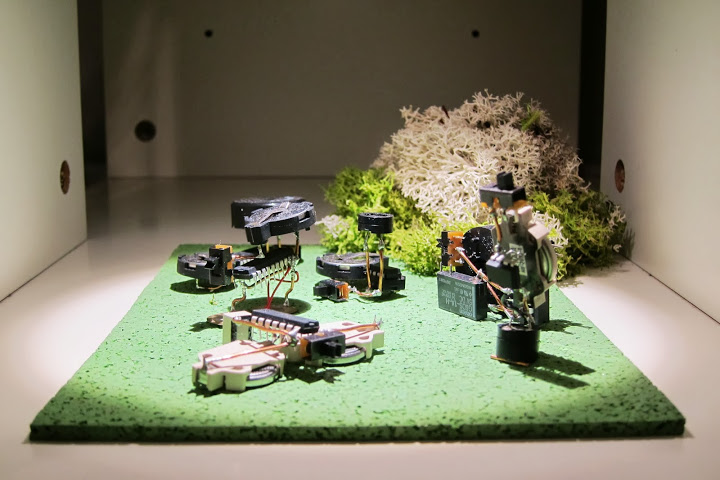“Cicadas” is an installation with a difference. Bringing together sound design, technology and natural science, Berlin-based sound artist Bob Meanza has created sonic robots which emulate some of the resonance and timbral qualities of the cicada.
These robots are in fact tinyAVR microcontrollers, programmed using Arduino software to emit sounds that are determined by their basic physical structure. The cicada is a tiny insect with immense sound-producing capabilities, with the singing of some variants has been measured at 100dB.[1] I asked Meanza a few questions about the project and the concepts and techniques that influenced it. Read his responses below and do check out his video and other related material for details on how this fascinating piece came together.
What inspired you to do this project? Why cicadas?
It all started as I was doing some research about granular synthesis. I was reading a quote by composer Iannis Xenakis, in which he describes the roaring and “granular” clouds of sound he experienced during the war. In order to give an idea of such sonic textures, he says: “a similar thing happens also when you listen to cicadas”. It’s just a quick example, nonetheless I was shocked by the sudden appearance of the peaceful cicadas in a war account! I started then to listen to recorded cicadas, trying to hear other sounds inside the texture, and of course it’s wonderfully hypnotic. I was born in Italy, where cicadas in summer are all over the place, and you almost stop noticing them. But in Berlin you have little chance to hear them live. So I guess it all started from a “cloud” of strange attractors: granular synthesis, Xenakis, war, field recording, and soundscape nostalgia.

Is it right that the sounds of the cicadas are 100% synthesized? What was the starting point for sculpting these sounds?
Yes, at the core of it there’s a kind of “virtual insect synthesis”, coded in the microcontrollers. But many important acoustic qualities of the sound do not come from the algorithm itself, rather from the kind of “speaker” element. For example a relay: you can control it in order to produce a “cloud” of clicks, but the click itself bears the footprint of the relay’s build qualities. I always liked relays. Every time I work with them I am amused by their old-fashioned, mechanical behaviour. Which is actually not so different from the vibrating membrane of cicadas: if you listen to an overdriven relay (maybe resulting to some failure in the circuit), you get the sonic parallel very clearly.
So how does the live installation work? What is the set up?
The Cicadas I present in the video are still “version 1”, and are very simple. They are all independent, battery-powered individuals, which once turned on start their singing life. They make pauses, they change intensity, choose different pitches, depending on random decisions and scored events. Together, they build an ever-changing soundscape. So the installation consists in letting the Cicadas free to “sonificate” an environment. People walk by and listen as much as they want. They can try to concentrate and go “into” the texture, as I did, but that’s not requested.
Also, nice results come when the Cicadas blend with some preexisting environment (as in the video I made for the project). Interestingly, at a recent exhibition it turned out that most people ended up chatting in the cicadas corner, not in the other ones. It was like, the funny soundscape encouraged people to “break the ice” – that was also very nice. Then, the installation formally ends when the batteries are over, a thing that seems quite appropriate to me.

Can you tell us more about the relationship between the physical structure of the cicada robots and the sounds that they emit (i.e. why do they emit different sounds)? Was there a particular concept behind this?
Finally, what other projects do you have in the pipeline?
As an electronic musician, I have also a sort of “regular” schedule of concerts. With visual artist Marco Mendeni, we’re presenting “I’m not playing”, a game art performance, based on the hacking of war videogames. There I am basically dissecting the work of the game’s sound designer, twisting it and trying again to show some strange clouds of attractors (war, games, “real sounds”, virtual sounds…). Then there will surely be a next breed of Cicadas. I’d like to add some feedback in their behaviour, although it will be hard not to break simplicity of the project. I’d like to go on working on the implicit meanings that this experience conveys, more than on seeking technical achievements. But apart of this, I definitely have to build more Cicadas, they need to be a swarm, by definition. They need to be clouds!
[vimeo]https://vimeo.com/74065419[/vimeo]http://rhizome.org/profile/bobmeanza/
http://rhizome.org/portfolios/artwork/57286/
Pictures courtesy of Bob Meanza
_________________________________
[1] Yang, Mackenzie, Cicadian Rhythm: Return of The Red-Eyed Insects in Time, 08 May 2013 [Accessed: 20 September 2013].
http://newsfeed.time.com/2013/05/08/cicadian-rhythm-the-return-of-the-red-eyed-insects/